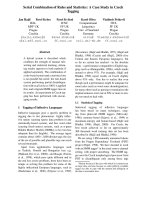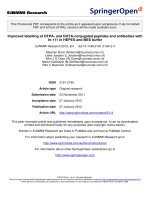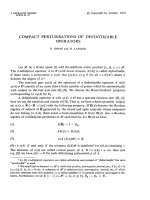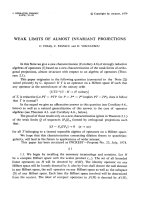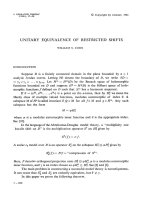Báo cáo toán học: " Reconstructing subsets of reals A.J. Radcliffe 1 Department of Mathematics and Statistics" pdf
Bạn đang xem bản rút gọn của tài liệu. Xem và tải ngay bản đầy đủ của tài liệu tại đây (106.35 KB, 9 trang )
Reconstructing subsets of reals
A.J. Radcliffe
1
Department of Mathematics and Statistics
University of Nebraska-Lincoln
Lincoln, NE 68588-0323
A.D. Scott
Department of Mathematics
University College
Gower Street
London WC1E 6BT
Submitted: November 24, 1998; Accepted: March 15, 1999
1
Partially supported by NSF Grant DMS-9401351
Abstract
We consider the problem of reconstructing a set of real numbers up to trans-
lation from the multiset of its subsets of fixed size, given up to translation.
This is impossible in general: for instance almost all subsets of contain
infinitely many translates of every finite subset of . We therefore restrict
our attention to subsets of which are locally finite; those which contain
only finitely many translates of any given finite set of size at least 2.
We prove that every locally finite subset of is reconstructible from the
multiset of its 3-subsets, given up to translation.
Primary: 05E99; Secondary: 05C60
1 Introduction.
Reconstructing combinatorial objects from information about their subob-
jects is a long-standing problem. The Reconstruction Conjecture and the
Edge Reconstruction Conjecture both deal with the problem of reconstruct-
ing a graph from a multiset of subgraphs; in one case the collection of all
induced subgraphs with one fewer vertex, in the other the collection of all
subgraphs with one fewer edge (see Bondy [2] and Bondy and Hemminger
[3]).
The very general problem is that of reconstructing a combinatorial object
(up to isomorphism) from the collection of isomorphism classes of its subob-
jects. Isomorphism plays a crucial rˆole. Thus it seems that the natural ingre-
dients for a reconstruction problem are a group action (to provide a notion of
isomorphism) and an idea of what constitutes a subobject. Reconstruction
problems have been considered from this perspective by, for instance, Alon,
Caro, Krasikov and Roditty [1], Radcliffe and Scott [11], [10], Cameron [4],
[5], and Mnukhin [7], [8], [9].
In this paper we consider the problem of reconstructing subsets of the
groups , ,and from the multiset of isomorphism classes of their subsets
of fixed size, where two subsets are isomorphic if one subset is a translate of
the other. Where the subsets have size k we call this collection the k-deck.
Maybe the first thing to notice is that for |A|≥k one can reconstruct
the l-deck of A from the k-deck for any l ≤ k. Thisisastraightforward
translation of Kelly’s lemma (see [2]). On the other hand if |A| <kthen the
k-deck of A is empty, and therefore A cannot be distinguished from any other
subset of size strictly less than k. It makes the statement of our theorems
slightly easier if we use a definition of deck for which this issue does not arise.
The definition we adopt below regards the deck as a function on multisets
of size k. It is straightforward to check that this form of the k-deck can be
determined from the deck as defined above, provided |A|≥k.
Definition 1
Let A be a subset of ,where is one of , ,or.The
k-deck of A is the function defined on multisets Y of size k from by
d
A,k
(Y )=|{i ∈ : supp(Y + i) ⊂ A}|,
where supp(Y )isthesetofelementsofY , considered without multiplicity.
We say that A is reconstructible from its k-deck if we can deduce A up to
the electronic journal of combinatorics 6 (1999), #R20 2
translation from its k-deck; in other words, we have
d
B,k
≡ d
A,k
⇒ B = A + i, for some i ∈ .
More generally we say that a function of A is reconstructible from the k-deck
of A if its value can be determined from d
A,k
.
Certain subtleties arise since the groups involved are infinite. It may be
that the k-deck of A ⊂ takes the value ∞ on some finite (multi)sets. In
fact, for any fixed finite subset F ⊂ , almost all subsets of (with respect
to the obvious symmetric probability measure on P()) contain infinitely
many translates of F.Thusitistrivialtofind,forallk ≥ 1, two subsets of
with the same k-deck which are not translates of one another.
For this reason we restrict our attention to subsets A ⊂ for which the
2-deck (and a fortiori the k-deck for all k ≥ 2) takes only finite values, or
equivalently, every distance occurs at most fintely many times. We shall call
such sets locally finite.
It is easily seen that every finite subset A ⊂ can be reconstructed from
its 3-deck, d
A,3
: indeed, let n =diamA := max A − min A;then
A {0,n}∪{r : d
A,3
({0,r,n}) > 0}.
The 2-deck is not, however, in general enough. For instance, if A and B are
finite sets of reals then A + B and A − B havethesame2-deck.
Our aim in this note is to prove a reconstruction result for locally finite
sets of reals. We begin by proving a result for and work in stages towards
. We shall write A B if A is a translation of B.
Theorem 1 Let A ⊂ be locally finite. Then A is reconstructible from its
3-deck. In other words, if A, B ⊂ have the same 3-deck then A B.
We shall first prove a lemma. For subsets A, B ⊂ ,wedefineA + B to
be the multiset of all a + b with a ∈ A and b ∈ B. (This multiset might of
course take infinte values). Thus, for finite A and B,ifweidentifyA with
a(x)=
i∈A
x
i
and B with b(x)=
i∈B
x
i
,thenA + B can be identified
with a(x)b(x), where the coefficient of x
i
in a(x)b(x) is the multiplicity of i
in the sum A + B.
If L is a multiset of we write m
L
(i) for the multiplicity of i in L.
Lemma 2 Let A, B, C ⊂ be finite and suppose that A+ C = B + C. Then
A = B.
the electronic journal of combinatorics 6 (1999), #R20 3
Proof. Straightforward by induction on |A|, noting that min(A + C)=
min A +minC.
Lemma 3 If A, B ⊂ are locally finite, infinite sets with A B finite, and
C is a finite set with A + C = B + C then A = B.
Proof. Let A
0
= A \ B,letB
0
= B \ A,andsetR = A ∩ B.Nowforalli
we have
m
A
0
+C
(i)=m
A+C
(i) − m
R+C
(i)
= m
B+C
(i) − m
R+C
(i)
= m
B
0
+C
(i).
Thus A
0
+ C = B
0
+ C and it follows from Lemma 2 that A
0
= B
0
and so
A = B.
Lemma 4 If A, B ⊂ are locally finite, infinite sets, and C is a finite set
with A + C = B + C then A = B.
Proof. We may suppose, without loss of generality, that 0 ∈ C.Nowlet
S = {i : C + i ⊂ A + C} and c =diam(C). We aim to show that, except
for a finite amount of confusion, we have S = A. To this end, let N be
sufficiently large such that for all distinct a, a
∈ A with |a| >Nwe have
|a
− a| > 4c and for all distinct b, b
∈ B with |b| >N we have |b
− b| > 4c.
(Such an N exists since A and B are locally finite.) Suppose now that k,with
|k| >N+4c, belongs to two sets from {C+i : i ∈ S},sayk ∈ (C+i)∩(C+j).
Define D =(C + i) ∪ (C + j). Since diam(D) >c,whileD ⊂ A + C,there
must be distinct elements a
1
,a
2
∈ A such that D meets both C + a
1
and
C + a
2
. But this is impossible, for then |a
1
− a
2
|≤4c, while |a
1
| >N.Thus
every k ∈ A+C with |k| >N+4c belongs to exactly one set C +i.Itfollows
that i ∈ A, and by the same reasoning i ∈ B.
Now set R = {i ∈ S : |i| >N+4c}. Wehavejustestablishedthat
R ⊂ A and R ⊂ B,andobviouslyR ⊃{a ∈ A : |a| >N+4c} and R ⊃
{b ∈ B : |b| >N+4c}.ThusA∆B is finite, and by Lemma 3 the result is
established.
Lemma 5 Let A, B ⊂ be locally finite infinite sets and let C, D ⊂ be
finite. If A + C = B + D then A B and C D.
the electronic journal of combinatorics 6 (1999), #R20 4
Proof. We may clearly assume that min C =minD = 0. Under this hy-
pothesis we will prove that A = B and C = D.
We will show that C (and equally D) is the largest set such that infinitely
many translates of C are contained in A + C = B + D. Suppose then that
A+C contains infinitely many translates of some set E and that no translate
of E is a subset of C.LetE
1
,E
2
, be translates of E,whereE
i
⊂ A + C
and | min E
i
|→∞as i →∞.SinceE iscontainedinnotranslateofC,
every E
i
must meet at least two translates of C,sayC
a
i
and C
b
i
,wherea
i
and b
i
are distinct elements of A. Thus there are distinct a
i
,b
i
∈ A with
|a
i
− b
i
|≤2diam(C)+diam(E)
and |a
i
|→∞; since there are only finitely many possibilities for a
i
− b
i
and
infinitely many a
i
, some distance must occur infinitely many times, which
contradicts the assumption that A is locally finite.
We conclude that C is the largest set (uniquely defined up to translation)
that has infinitely many translates as subsets of A+C.HencewehaveC D
and so C ≡ D,sinceminC =minD.ThusA + C = B + D = B + C,and
by Lemma 4, A = B.
Proof. [of Theorem 1] If A is finite then it is easily reconstructed from its
3-deck, as noted above. Thus we may assume that A is infinite.
Let k be a difference that occurs in A (i.e. there are a
1
,a
2
∈ A with
a
1
− a
2
= k). We shall show that A can be reconstructed from its 3-deck;
moreover, it can be reconstructed from its 3-deck restricted to multisets of
the form {0,k,α}. Indeed, let B be another set with the same 3-deck. Define
X
A
= {a ∈ A : a + k ∈ A}
and
X
B
= {b ∈ B : b + k ∈ B}.
Then, translating if necessary, we may assume that min X
A
=minX
B
.We
claim now that A = B.
In order to prove our result it is enough to show that −A+X
A
= −B+X
B
,
for then the result follows immediately from Lemma 5: since −A = −B we
also have A = B.
Now for i ∈ , the multiplicity of i in −A + X
A
is
|{j : j ∈ X
A
,i− j ∈−A} = |{j : j ∈ X
A
,j− i ∈ A}|
= |{j : j, j + k, j − i ∈ A}|.
the electronic journal of combinatorics 6 (1999), #R20 5
If i =0, −k, then this is the multiplicity of {0,i,i+ k} in the 3-deck of A;if
i =0ori = −k then this is |X
A
|, the multiplicity of {0,k} in the 2-deck of
A. Clearly, similar calculations hold for B,so−A + X
A
= −B + X
B
.
Theorem 6 Lemmas 2, 3, 4, and 5 hold in
n
for all positive integers n.
Moreover if A, B ⊂
n
have the same 3-deck then A B.
Proof. The proofs are almost identical to those for the corresponding results
about . Weusethenorm|a| = a
2
, and order
n
lexicographically, so
a ≤ b if the first nonzero coordinate of b − a is positive. The assumptions
min C =minD in the proof of Lemma 2 and min X
A
=minX
B
in the
proof of Theorem 1 then make sense. Moreover, the claim in the proof of
Lemma 4 that diam(D) > diam(C) is easily seen to hold in
n
also: suppose
D =(C+i)∪(C+j)andx, y ∈ C satisfy |x−y| =diam(C). Let v = i−j =0.
Now |(x + i) − (y + j)| = |(x − y)+v| and |(x + j) − (y + i)| = |(x − y) − v|
and one of these two norms is strictly greater than |x − y| =diam(C)(by
the strict convexity of the norm we have chosen).
Theorem 7 Let A, B ⊂ be locally finite and have the same 3-deck, then
A B.
Proof. Suppose A and B are locally finite subsets of with the same 3-
deck. Let k be some distance that occurs in A, and again define X
A
=
{a ∈ A : a + k ∈ A} and X
B
= {b ∈ B : b + k ∈ B} as in the proof of The-
orem 1. We may assume min X
A
=minX
B
= 0. Now suppose n is an integer
such that 1/n divides k and all differences in X
A
and X
B
.Thatis,nk ∈
and for all q,r ∈ X
A
∪ X
B
we have n(q − r) ∈ . In particular nq ∈ for all
q ∈ X
A
∪ X
B
. We will show that for all i we have
A ∩
1
in
= B ∩
1
in
Since =
i≥1
1
in
the result will then be proved.
As in the proof of Theorem 1, it is enough to show that the 3-decks of
A∩
1
in
and B ∩
1
in
, restricted to multisets of form {0,k,α}, are equal. Now
if a + {0,k,α}⊂A then a ∈ X
A
,andso
a + {0,k,α}⊂A ∩
1
in
⇐⇒ a + α ∈
1
in
⇐⇒ α ∈
1
in
.
the electronic journal of combinatorics 6 (1999), #R20 6
Thus the relevant parts of the 3-decks of A ∩
1
in
and B ∩
1
in
are equal, and
hence A ∩
1
in
= B ∩
1
in
.
Theorem 8 Let A ⊂
n
be locally finite. Then A is reconstructible from
its 3-deck.
Proof. Similar to the proof of Theorem 7, with modifications as indicated
in the proof of Theorem 6.
Theorem 9 Let A ⊂ be locally finite. Then A is reconstructible from its
3-deck.
Proof. Let {q : q ∈ I} be a Hamel basis for over , where the set I is
well-ordered by ≺. This induces a total ordering on by defining x<yiff
y − x =
n
i=1
a
i
q
i
with q
1
≺ q
2
≺···≺q
n
and a
1
> 0. Given a subset S ⊂ R
we write S for the collection of finite -linear combinations of elements of
S.
Now suppose that A, B ⊂ are locally finite, and that the 3-decks of
A and B are the same. Let r be a distance that occurs in A and let X
A
=
{a ∈ A : a + r ∈ A},andX
B
= {b ∈ B : b + r ∈ B}. We may assume that
min X
A
=minX
B
=0. LetI
0
⊂ I be a finite subset of I such that x−y ∈I
0
for all x, y ∈ X
A
∪X
B
,andalsor ∈I
0
. Such a subset exists, since X
A
∪X
B
is finite and every element of can be written as a -linear combination of
a finite set of elements from I.
We will show that for finite subsets J with I
0
⊂ J ⊂ I,thesetsA ∩J
and B ∩J are equal, from which it easily follows that A = B.Consider
then such a J.Ifa + {0,r,α}⊂A then a ∈ X
A
and
a + {0,r,α}⊂A ∩J⇐⇒a + α ∈J
⇐⇒ α ∈J .
Since J is isomorphic to
N
,forsomeN,and,bytheargumentabove,
the 3-decks of A ∩J and B ∩J restricted to multisets of form {0,r,α}
are the same, it follows from Theorem 8 that A ∩J = B ∩J.Since
J⊃I
0
J = ,wehavethatA = B.
It would be interesting to have a measure-theoretic version of this result.
Let S be a Lebesgue-measurable set of reals, and for every finite set X, define
S(X)=λ(x : X + x ⊂ S). Call S locally finite if S(X) is finite whenever
|X| > 1. We regard sets X, Y as equivalent if λ(X (Y + t)) = 0 for some
the electronic journal of combinatorics 6 (1999), #R20 7
real number t. Can we reconstruct every set of finite measure from its 3-
deck? Can we reconstruct every locally finite set from its 3-deck? Or from
the k-deck for sufficiently large k?
References
[1] N. Alon, Y. Caro, I. Krasikov and Y. Roditty, Combinatorial reconstruc-
tion problems, J. Comb. Theory, Ser. B 47 (1989), 153–161
[2] J. A. Bondy, A graph reconstructor’s manual, in Surveys in Combina-
torics, 1991, ed. A.D. Keedwell, LMS Lecture Note Series 166, 221–252
[3] J. A. Bondy and R. L. Hemminger, Graph reconstruction – a survey, J.
Graph Theory 1 (1977), 227–268
[4] P. J. Cameron, Stories from the age of reconstruction, Festschrift for
C. St. J. A. Nash-Williams, Congr. Numer. 113 (1996), 31–41
[5] P. J. Cameron, Some open problems on permutation groups, in
M. W. Liebeck and J. Saxl, eds, Groups, Combinatorics and Geometry,
London Mathematical Society Lecture Notes 165, CUP, 1992, 340-351
[6] I. Krasikov and Y. Roddity, On a reconstruction problem for sequences,
J. Comb. Theory, Ser. A 77 (1977), 344-348
[7] V.B.Mnukhin,Thek-orbit reconstruction and the orbit algebra, Acta
Appl. Math. 29 (1992), 83–117
[8] V. B. Mnukhin, The reconstruction of oriented necklaces, J. Combina-
torics, Information and System Sciences, 20 (95), 261-272
[9] V.B.Mnukhin,Thek-orbit reconstruction for Abelian and Hamiltonian
groups, Acta Applicandae Mathematicae 52 (98), 149-162
[10] A. J. Radcliffe and A. D. Scott, Reconstruction subsets of
n
,J.Comb.
Theory,Ser.A83 (98), 169-187
[11] A. J. Radcliffe and A. D. Scott, Reconstructing subsets of non-Abelian
groups, manuscript.
